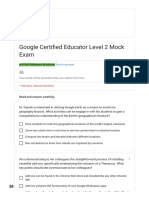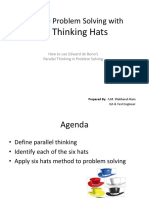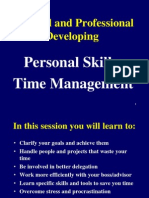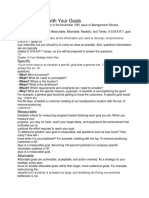Time Management Audit
Time Management Audit
Uploaded by
Anu Abraham MathewCopyright:
Available Formats
Time Management Audit
Time Management Audit
Uploaded by
Anu Abraham MathewCopyright
Available Formats
Share this document
Did you find this document useful?
Is this content inappropriate?
Copyright:
Available Formats
Time Management Audit
Time Management Audit
Uploaded by
Anu Abraham MathewCopyright:
Available Formats
Bite-Sized Training™
Time Management Audit
Time Management Audit
Bite-Sized Training
This e-book is published by Mind Tools Ltd.
Copyright © Mind Tools Ltd, 2007-2014. All rights reserved.
Version 2.0.
This e-book is protected by international copyright law.
You may use it only if you are a member of the Mind
Tools Club™. If you have any queries, please contact us at
members.helpdesk@mindtools.com.
“Mind Tools” is a registered trademark (US 4,566,696, EU
012473377) of Mind Tools Ltd.
Cover image © iStockphoto/ermingut.
Contents
1. Introduction 1
2. Where Does Your Time Go? (Part 1) 2
3. Where Does Your Time Go? (Part 2) 6
4. Is Your Time Well Spent? 7
5. Auditing Your Inbox 11
6. Key Learning Points 14
Time Management Audit Bite-Sized Training™ | Mind Tools iii
1. Introduction
Y
ou come into the office on Monday morning, sit down at your desk,
and organize your To-Do List with all the tasks you want to complete
during the day. As you start working, you feel confident that you can
do everything.
However, by the end of the day, you’ve only completed a few of your tasks, and
you’re not sure where the time has gone.
Unless you’re a practiced time manager, you may not be fully aware of how you
spend your time. You’ll likely have a general idea, but you may be shocked by
the truth!
It’s important to keep track of time, because it’s often the resource we have in
shortest supply. Taking stock of your time enables you to decide where best to
allocate the precious hours you have.
Think of your time like a product on a warehouse shelf. When your customers
demand it, you dole it out on a first-come-first-served basis. This means that the
shelf will soon be empty, and the people who got there first are not necessarily the
most deserving of this precious resource.
Just as a business monitors its stock levels, you need to keep track of your time.
How much do you have available? How much should you dedicate to certain
activities? Do you have some available to deal with unexpected demands? You can
answer these types of questions by carrying out a time management audit.
In this Bite-Sized Training™ session, we’ll explore how you can do this. Since you
can’t increase the number of hours in your day, you need to be diligent about
tracking and optimizing the time you have.
In this session, you will:
• Complete an Activity Log, so that you can track exactly what you do.
• Analyze the types of activities that take up most of your time.
• Build a system to manage your inbox effectively, using delegation and
prioritization techniques.
Note:
We present this Bite-Sized Training session in a slightly different format from
our usual ones. Instead of completing it in an hour, we ask you to spend a week
tracking and recording your time, and then return to finish the workbook.
Time Management Audit Bite-Sized Training™ | Mind Tools 1
2. Where Does Your Time Go? (Part 1)
B
efore you can allocate your time effectively, you need to know how you
spend it. And you may be surprised by what you discover if you haven’t
tracked your hours before. Do you really know:
• How much of your day you spend on productive work?
• What percentage of your time you dedicate to your responsibilities?
• How many minutes (or hours) you dedicate to managing and
recovering from interruptions?
To answer these questions, you need to estimate how long certain activities take,
and then compare this figure with how much time you actually spend on them.
Action:
List the main activities that make up your working day on the next page. Start
with the first tasks you need to complete in the morning, and try to group similar
jobs together. Include an “other” or “miscellaneous” activity for the things that
aren’t easily definable.
Time Management Audit Bite-Sized Training™ | Mind Tools 2
Activity Estimated Time Spent (%) Actual Time Spent (%)
Time Management Audit Bite-Sized Training™ | Mind Tools 3
Action:
Next, think about a typical working week, and add any activities that you haven’t
already included to the table on the previous page. When you are satisfied that
your list covers your main tasks, complete the estimated time column.
To calculate the actual time you spend on these activities, you need to
complete an Activity Log. This is an accurate record of everything you do over a
certain period.
To record your time in an Activity Log, simply write down when you start a task,
describe what you are doing, and then note how long you worked on it. You need
to record the time, description and duration every time you change activities.
Here’s an example of a morning at the office:
Value
Time Activity Duration
(High/Medium/Low)
8:00 am Check emails. 15 min Med
8:15 am Team meeting. 10 min High
Chat to colleague in the
8:25 am 15 min Low
hall after the meeting.
Check phone messages,
8:40 am 15 min Low
return calls.
8:55 am Get coffee. 10 min High
9:05 am Software project. 20 min Med
Consultation: colleague
comes to door to discuss
9:25 am the presentation we are 40 min Low
making to the Board
next week.
10:05 am Take break in staff room. 15 min Low
10:20 am Check new emails. 10 min High
Reorganize software
10:30 am project materials and get 30 min Med
back to work.
Time Management Audit Bite-Sized Training™ | Mind Tools 4
Provide staff member
11:00 am with directions/ideas for 10 min High
the work they are doing.
Software project – try to
11:10 am 10 min Med
get back to work.
Phone call with
11:20 am boss about the 10 min High
software project.
Refocus on the software
11:30 am 40 min Med
project work.
12:10 pm Lunch. 65 min
Total Time:
315 minutes
When you complete an Activity Log, it’s important to fill in the “value” column.
Here, you gauge how important a task is to your organization and to achieving
your goals. Ultimately, you should aim to spend the majority of your time on
high-value tasks and minimize low-value activities as much as sensibly possible.
In our example, only 35 percent of the person’s morning (110 of the 315 minutes
accounted for) was spent on high-value tasks.
Action:
Use the Activity Log template on page 15 to record your tasks over the next
week. Try to use the same activity categories that you used on page 3 (this will
make it easier to compare your estimated and actual times).
Make a note in your diary to resume this training session in a week’s time.
Tip:
See our article for more on Activity Logs.
Time Management Audit Bite-Sized Training™ | Mind Tools 5
3. Where Does Your Time Go? (Part 2)
N
ow that you’ve completed your Activity Log, are you surprised by where
your time goes?
It’s amazing to learn what we really do over the course of a day. This
powerful exercise is often the turning point for people who struggle with
time management. Knowing how long you spend on tasks enables you to start
taking control with solid planning.
How well do you think you estimated your time usage? Let’s find out.
Action:
Gather up your Activity Log sheets for the week. Calculate the total amount of
time you accounted for, and record the percentage you spent on each activity in
the “actual time spent” column on page 3. Then, answer the questions below.
What have you learned about the way you spend your time? Were your estimates accurate? If not,
why do you think this is? What surprised you the most?
Time Management Audit Bite-Sized Training™ | Mind Tools 6
4. Is Your Time Well Spent?
S
o far, you’ve identified what you’re really spending your time on, and you’ve
categorized your tasks to show whether they are high, medium or low
value. Next, we’ll identify where your real priorities lie. This will help you
determine which actions you should keep doing, which you should do
more of, and which you should stop doing.
The purpose of a time management audit is to allocate your available hours more
effectively. To do this, you need to identify which activities are high priority and
which are not, and this is where the Action Priority Matrix is useful.
You can use this tool (see Figure 1, below) to put each of your tasks into one of four
categories, based on its impact and how much effort it requires.
Figure 1: Action Priority Matrix
Time Management Audit Bite-Sized Training™ | Mind Tools 7
The four quadrants are:
• Quick Wins – these are tasks that return high value for the time and effort
you put in. The more “quick wins” you can accomplish, the better.
• Major Projects – these are high impact, high effort, time consuming
projects. It’s easy to let these monopolize your schedule, so you need to
make sure that you’re using your time efficiently.
• Fill Ins – these are the low impact, low effort tasks that you should
complete in any time that’s spare. If you don’t have any capacity, these just
don’t have to get done!
• Thankless Tasks – these are the activities that give meaning to the phrase
“work smarter, not harder.” If you are spending lots of time and effort on
something that will give you a low return, there is no reason to continue.
Either drop the task, allocate it to someone who can do it quicker (a
specialist), or delegate it to a more junior team member.
Action:
Determine the position of each of the activities that you identified on page 3 on
the Action Priority Matrix, and record them on the next page. In the “present”
column, include an approximate percentage of time you spend on each.
Time Management Audit Bite-Sized Training™ | Mind Tools 8
Quick Wins Major Projects
Activity Present Proposed Activity Present Proposed
Fill Ins Thankless Tasks
Activity Present Proposed Activity Present Proposed
Time Management Audit Bite-Sized Training™ | Mind Tools 9
Action:
Take a moment to think about how efficiently you are currently allocating
your time. Are there “thankless tasks” that you can delegate or drop? Are you
spending too much time on “fill ins”?
In the “proposed” column for each activity, indicate whether you will:
• Drop the item.
• Delegate it.
• Decrease the time spent – give a new time percentage.
• Increase the time spent – give a new time percentage.
This is the start of your new time-management plan. You’ll find it much easier to
organize your day now that you have a big-picture idea of how to allocate the
hours you have available.
Time Management Audit Bite-Sized Training™ | Mind Tools 10
5. Auditing Your Inbox
F
or many of us, dealing with email and other communications takes up
a large part of our day. Therefore, no time management audit would
be complete without examining how best to handle this necessary but
time-consuming task.
Some people check their emails every few minutes, excited by what might
arrive. Others ignore their inboxes, hoping that the contents will disappear by
themselves. Although it’s important to keep on top of your emails, you risk wasting
time and lowering your productivity if you check them too often.
How do you currently manage your inbox? Do you deal with messages in
chronological or reverse order? By how much you like the sender? By how
interesting the subject line sounds? By focusing on jokes, YouTube® clips,
Buzzfeed® quizzes, or humorous memes first? Or maybe last?
Your goal is to handle emails in order of priority. When you have a system for
prioritizing and dealing with messages, you will do it much more quickly, and you
will be much more effective.
Action:
Think about how you currently manage your inbox. How efficient are you?
Give yourself a rating from 1 to 10 (1 = inefficient, 10 = very efficient).
First, you should aim to schedule one or two blocks of time to deal with email
throughout the day. For example, first thing in the morning and right after lunch.
Time Management Audit Bite-Sized Training™ | Mind Tools 11
Action:
Look over your time management audit on page 15, and decide how long to
allocate to email management each day. Record this below.
Total time allocated to email management:
Number of sessions I will divide this into:
Session time:
Session time:
Session time:
Session time:
When you have a number of emails in your inbox, work through them in the
order that you received them. This addresses the time-sensitive nature of some
messages, and it ensures that you don’t miss one by mistake. Check for any
follow-up messages that you need to read before you reply (some email clients,
such as GMail®, will automatically stack your messages into “threads” for you).
The 4 Ds!
You now know when you will deal with email, so the next step is to decide how.
The “4 D” system is extremely effective for managing your inbox. For each message
that comes in, you have four options:
• Do it – for simple requests and responses, just do it! It’s easier to hit “reply” and
respond quickly than it is to set the email aside for prioritization. “Do it” also
applies to items that you don’t need to act on but want to file for reference.
• Delete it – after you’ve skimmed an email and decided it’s not actionable,
and you don’t need to keep it, delete it or archive it. If you’re worried about
permanently removing messages, set up a folder for “To Delete” items.
You then take them out of your inbox, and you can deal with your “delete
anxiety” later.
• Delegate it – does someone else need to act on this information? Is it
something you don’t need to deal with personally? Try to delegate as
much as you sensibly can.
• Decide its priority – the emails that are left are the ones you need to act
on. But first, you need to prioritize them. An email isn’t the most important
one just because you read it first or it came from your boss.
Time Management Audit Bite-Sized Training™ | Mind Tools 12
Action:
In the table below, record the last five emails that you received, and note down
your action for each (Do, Delete, Delegate, Decide).
Email Action Priority
Assign a priority order for the items that are either “delegate” or “decide.”
Tip:
For more on prioritization techniques, see our article and Bite-Sized
Training session.
Action:
Now that you have an effective strategy for managing your inbox, how
efficient do you think you’ll be? More than before?
Give yourself a rating from 1 to 10 (1 = inefficient, 10 = very efficient).
This is a really simple way to tame your inbox. By cutting out the “noise” of
unimportant emails that demand your attention, you will find that you can
manage your messages effectively, and schedule email into your day like any other
routine task.
Time Management Audit Bite-Sized Training™ | Mind Tools 13
6. Key Learning Points
Y
ou have little hope of taking control of your time until you know where
it goes. Completing an Activity Log enables you to identify which tasks
take the most time, and helps you pinpoint both the unimportant and the
high-value activities that fill your day.
Using the Action Priority Matrix gives you a very clear view of which activities
you should be doing, and which you should delegate or drop. When you look at a
task’s impact and the effort it takes to complete, you might be surprised by what is
actually an effective use of your time.
Finally, taking control of email is a huge step towards effective time management.
With some decisive action and solid prioritizing, you can get your inbox under
control and get on with the things that really need your attention.
Trademark Information
“YouTube” and “GMail” are trademarks of Google, Inc. (see www.youtube.com)
and mail.google.com), and “Buzzfeed” is a trademark of Buzzfeed, Inc. (see
www.buzzfeed.com).
Time Management Audit Bite-Sized Training™ | Mind Tools 14
Activity Log
Print off as many copies of this as you need for your personal use.
Value
Time Activity Duration
(High/Medium/Low)
Time Management Audit Bite-Sized Training™ | Mind Tools 15
You might also like
- 2 Steps To Get CPNDocument9 pages2 Steps To Get CPNniki93% (29)
- Spamming TutDocument5 pagesSpamming TutManuel Dnte Josue83% (6)
- Google Certified Educator Level 2 Mock ExamDocument26 pagesGoogle Certified Educator Level 2 Mock ExamMOHD YUSNIZAM BIN MOHAMAD (D-PPDTUMPAT)67% (3)
- Fox Lion and ST BernardDocument19 pagesFox Lion and ST BernardDhani DPNo ratings yet
- Team Building ExercisesDocument4 pagesTeam Building ExercisesDurva JadhavNo ratings yet
- Bite-Sized Training™: Time Management AuditDocument17 pagesBite-Sized Training™: Time Management AuditJoulo YabutNo ratings yet
- Stress Activities Part 1Document22 pagesStress Activities Part 1JGO0% (5)
- How To Hack Facebook Account Through Keylodger - 1Document3 pagesHow To Hack Facebook Account Through Keylodger - 1Joshua JosephNo ratings yet
- Work From HomeDocument29 pagesWork From HomeAna Zahida80% (5)
- 7 Quick Wins v.5 PDFDocument8 pages7 Quick Wins v.5 PDFmarcola256No ratings yet
- BiteSizedTraining EmpowermentDocument11 pagesBiteSizedTraining EmpowermentShelton HillNo ratings yet
- Bite-Sized Training™: What Is Operations Management?Document15 pagesBite-Sized Training™: What Is Operations Management?Joulo YabutNo ratings yet
- Time Management: Until We Can Manage Time, We Can Manage Nothing Else. Peter DruckerDocument27 pagesTime Management: Until We Can Manage Time, We Can Manage Nothing Else. Peter DruckerSakshi BansalNo ratings yet
- Bite-Sized Training™: What Is IT Management?Document11 pagesBite-Sized Training™: What Is IT Management?Joulo YabutNo ratings yet
- BiteSizedTraining ProblemSolvingDocument13 pagesBiteSizedTraining ProblemSolvingAnielaLTC100% (2)
- Bite-Sized Training™: Get Creative!Document13 pagesBite-Sized Training™: Get Creative!Joulo YabutNo ratings yet
- Stress Busters: Bite-Sized Scenario Training™Document17 pagesStress Busters: Bite-Sized Scenario Training™Alyssa Rigon100% (1)
- BiteSizedTraining-EffectiveTeams - Bruce Tuckman'sDocument19 pagesBiteSizedTraining-EffectiveTeams - Bruce Tuckman'sirfan farajNo ratings yet
- Style of LearningDocument20 pagesStyle of LearningSab 1001No ratings yet
- Bite-Sized Training™: Finding Your Unique StrengthsDocument17 pagesBite-Sized Training™: Finding Your Unique StrengthsJoulo YabutNo ratings yet
- Goal Setting Workbook PDFDocument10 pagesGoal Setting Workbook PDFElena HallNo ratings yet
- Learning Mat Team WorkerDocument2 pagesLearning Mat Team Workermetronomme100% (1)
- Summary 2 TCH Story PitchDocument2 pagesSummary 2 TCH Story PitchVasanth RajaNo ratings yet
- Situational Leadership ApproachDocument16 pagesSituational Leadership ApproachNayama NayamaNo ratings yet
- 25 Ways To Develop A Growth MindsetDocument3 pages25 Ways To Develop A Growth MindsetHibiscos100% (2)
- Time ManagementDocument16 pagesTime ManagementAman NiranjanNo ratings yet
- English: Week 9 - Elevator PitchesDocument14 pagesEnglish: Week 9 - Elevator PitchesMeryem100% (1)
- BiteSizedTraining TrainingDocument16 pagesBiteSizedTraining TrainingJoulo YabutNo ratings yet
- Oaching Models: Why The Grow Coaching Model?Document8 pagesOaching Models: Why The Grow Coaching Model?aziz moniesson s.No ratings yet
- Career Toolkit:: Finding A Job in Times of CrisisDocument20 pagesCareer Toolkit:: Finding A Job in Times of CrisiswcornierNo ratings yet
- Setting Sail With The 7 HabitsDocument18 pagesSetting Sail With The 7 Habitsretaniautami93No ratings yet
- USW HOW TO GUIDE 12 Time Management PDFDocument2 pagesUSW HOW TO GUIDE 12 Time Management PDFolynka85No ratings yet
- Online Training EbookDocument12 pagesOnline Training EbookEdwin PerezNo ratings yet
- Objective: How Should I Make This Presentation?" What Approach Should You Use? Formal or Informal?Document12 pagesObjective: How Should I Make This Presentation?" What Approach Should You Use? Formal or Informal?nicoletabuzatuNo ratings yet
- USW HOW TO GUIDE 12 Time Management PDFDocument2 pagesUSW HOW TO GUIDE 12 Time Management PDFOlgaBraga100% (1)
- Creative Problem Solving With: Six Thinking HatsDocument20 pagesCreative Problem Solving With: Six Thinking Hatszaya sarwarNo ratings yet
- Questions To Ask Yourself About Time ManagementDocument4 pagesQuestions To Ask Yourself About Time ManagementYhoshy ZeballosNo ratings yet
- Bite-Sized Training - Mentoring - HelenaDocument15 pagesBite-Sized Training - Mentoring - HelenageorjalynjoyNo ratings yet
- Honesty-and-Integrity-Lesson-ALLmy VerbsDocument15 pagesHonesty-and-Integrity-Lesson-ALLmy VerbsrituNo ratings yet
- Team BuildingDocument86 pagesTeam Buildingdhani_is100% (2)
- Team Building Tool KeysDocument84 pagesTeam Building Tool KeysangelsergioNo ratings yet
- 5 Organizational Skills Every Manager Must Know: Are You That Kind of ManagerDocument11 pages5 Organizational Skills Every Manager Must Know: Are You That Kind of ManagerAnonymous Q3XslQXUNo ratings yet
- 7 Habits of Highly Effective PeopleDocument16 pages7 Habits of Highly Effective PeopleTejaswini100% (1)
- Self ManagementDocument2 pagesSelf Managementdongpc1No ratings yet
- CSP 621 Growth Mindset Lesson PlanDocument4 pagesCSP 621 Growth Mindset Lesson Planapi-548723359No ratings yet
- 02-Time ManagementDocument62 pages02-Time ManagementMaryam Gul0% (1)
- Public Speaking TipsDocument5 pagesPublic Speaking Tipsclaudio-profissionalNo ratings yet
- The 38 Best Methods of Successful ExercisersDocument12 pagesThe 38 Best Methods of Successful ExerciserssebastianbirdxNo ratings yet
- Time Management: Stalin Paul Mba 1 Year 10 MBA 50Document10 pagesTime Management: Stalin Paul Mba 1 Year 10 MBA 50Sharmila BalanNo ratings yet
- Circle of ControlDocument3 pagesCircle of Controlnurulisyraq9No ratings yet
- Week 3 - Communication SkillsDocument28 pagesWeek 3 - Communication SkillsIodanutzs UkNo ratings yet
- Be S.M.a.R.T. With Your GoalsDocument4 pagesBe S.M.a.R.T. With Your GoalsajismandegarNo ratings yet
- Time Management: Pros & Cons: Presentation by Yulia ShvydkaDocument16 pagesTime Management: Pros & Cons: Presentation by Yulia ShvydkaЮлія ШвидкаNo ratings yet
- Lean ToolsDocument9 pagesLean ToolsMd MasumNo ratings yet
- Managing Conflict: Bite-Sized Scenario Training™Document13 pagesManaging Conflict: Bite-Sized Scenario Training™Joulo Yabut50% (2)
- Timemanagementingroupwork 190518175604Document23 pagesTimemanagementingroupwork 190518175604api-463725487No ratings yet
- CoachingDocument54 pagesCoachingFarrukh Jamil100% (2)
- Time ManagmentDocument15 pagesTime ManagmentJawad AhmadNo ratings yet
- Mindtools AssessmentDocument4 pagesMindtools Assessmentapi-272993959No ratings yet
- Whats My Coaching Style Sample Online ReportDocument11 pagesWhats My Coaching Style Sample Online Reportmc4bballNo ratings yet
- MyTyme WorkShopDocument72 pagesMyTyme WorkShopcoottyNo ratings yet
- The Urgent-Important MatrixDocument2 pagesThe Urgent-Important MatrixHelp Tubestar CrewNo ratings yet
- 13 Strategies To Jumpstart Your ProductivityDocument14 pages13 Strategies To Jumpstart Your ProductivityVenugopalan ManaladikalamNo ratings yet
- Bite-Sized TrainingWhat Is HR - Helena Smalman-SmithDocument12 pagesBite-Sized TrainingWhat Is HR - Helena Smalman-SmithgeorjalynjoyNo ratings yet
- Analyze Your Current ActivitiesDocument3 pagesAnalyze Your Current Activitiesrose lakeNo ratings yet
- The Path To Financial FreedomDocument9 pagesThe Path To Financial FreedomVansh MayatraNo ratings yet
- JuxtConsult India Online 2007 Internet Users by Socio Economic Classification ReportDocument183 pagesJuxtConsult India Online 2007 Internet Users by Socio Economic Classification ReportJuxtConsult Pvt. Ltd.100% (1)
- Top Links December 2018Document68 pagesTop Links December 2018Andrew Richard ThompsonNo ratings yet
- Buy Google Voice NumberDocument1 pageBuy Google Voice Numberjohnjuni300No ratings yet
- Gmail - Re - Job - Grap Excellent Opportunity With Marlabs Software - BE - BDocument3 pagesGmail - Re - Job - Grap Excellent Opportunity With Marlabs Software - BE - BRahul JainNo ratings yet
- Anurag - Hacking With ExpertsDocument128 pagesAnurag - Hacking With ExpertsProsper Emonena0% (1)
- Top 10 Email Marketing Metrics For EcommerceDocument3 pagesTop 10 Email Marketing Metrics For EcommerceLorena CidroNo ratings yet
- Send Email From Yahoo, Gmail, Hotmail (C#) - CodeProjectDocument3 pagesSend Email From Yahoo, Gmail, Hotmail (C#) - CodeProjectManoj Kumar GNo ratings yet
- InstructionsDocument5 pagesInstructionsapi-302398733No ratings yet
- CardingDocument20 pagesCardingLucky Maharaj100% (8)
- Google Calender Case StudyDocument21 pagesGoogle Calender Case StudyAnkith naiduNo ratings yet
- Strategic ManagementDocument33 pagesStrategic ManagementChandu De SilvaNo ratings yet
- APK Customer Service Guide 2.2Document37 pagesAPK Customer Service Guide 2.2Khushboo DelivalaNo ratings yet
- Gmail - Need WhatsApp Business Support PDFDocument2 pagesGmail - Need WhatsApp Business Support PDFSavari RajNo ratings yet
- Gmail - DXC (HP) - Immediate Joiners - Sr. Cognos DevelopersDocument2 pagesGmail - DXC (HP) - Immediate Joiners - Sr. Cognos DevelopersSandeepPamaratiNo ratings yet
- Guidebook For Organizer (English)Document18 pagesGuidebook For Organizer (English)Youth For NationNo ratings yet
- Internet Cafe Cafesuite 3 50 PDFDocument25 pagesInternet Cafe Cafesuite 3 50 PDFEd DecatoriaNo ratings yet
- Google Workspace TipsDocument34 pagesGoogle Workspace TipssagarNo ratings yet
- Method 1: Transfer Whatsapp Messages & Chats From Android To Iphone in One ClickDocument4 pagesMethod 1: Transfer Whatsapp Messages & Chats From Android To Iphone in One ClickmmmmNo ratings yet
- Gartner MarketScope For Email Systems, 2011Document10 pagesGartner MarketScope For Email Systems, 2011Rajendra KumarNo ratings yet
- DataSuite Release NotesDocument10 pagesDataSuite Release NotesesNo ratings yet
- ASUS ROG Phone 6 ManualDocument89 pagesASUS ROG Phone 6 ManualYuan LinNo ratings yet
- Chapter 9 - Google AppsDocument9 pagesChapter 9 - Google Appspearl.guptaNo ratings yet
- O e A G: Seminar OnDocument26 pagesO e A G: Seminar Onsubhawaiting4uNo ratings yet
- How To Solve Linear Sitting Arrangement - Concept & TipsDocument12 pagesHow To Solve Linear Sitting Arrangement - Concept & TipsEsakkiPonniahNo ratings yet

























































































